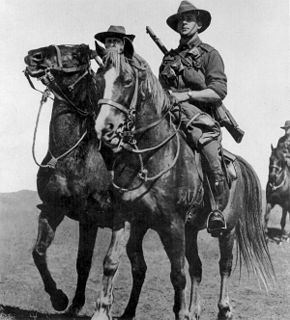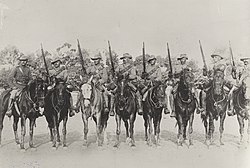
Australian Light Horse were mounted troops with characteristics of both cavalry and mounted infantry, who served in the Second Boer War and World War I. During the inter-war years, a number of regiments were raised as part of Australia's part-time military force. These units were gradually mechanised either before or during World War II, although only a small number undertook operational service during the war. A number of Australian light horse units are still in existence today.

The 2nd/14th Light Horse Regiment is a regiment of the Australian Army and forms part of the Royal Australian Armoured Corps. The regiment is an Australian Light Horse unit, and has been widely romanticised and popularised in literature and poetry throughout the 20th Century. The unit sentimentally traces its lineage to 1860 and is the oldest Australian Regular Army unit through antecedent units the 2nd Moreton Light Horse (QMI) and the 14th West Moreton Light Horse (QMI). The regiment is assigned to 7th Brigade based in Brisbane and is equipped with the M1A1 Abrams tank and the ASLAV reconnaissance vehicle.

The Royal New South Wales Regiment (RNSWR) is a reserve infantry regiment of the Australian Army based in the state of New South Wales.

The Queen Nandi Mounted Rifles is an reserve armoured regiment of the South African Army.

The Battle of Diamond Hill (Donkerhoek) was an engagement of the Second Boer War that took place on 11 and 12 June 1900 in central Transvaal.
Marshall's Horse was a South African cavalry unit formed in 1899 at the start of the Second Boer War to provide military support for the British campaign. The unit was created from the Uitenhage Rifles and 1st City (Grahamstown) Volunteers. They formed in Grahamstown, initially comprising 244 members before rising to 500 in late 1899. The unit's first commanding officer was Major George Marshall CMG.

The 1st Royal New South Wales Lancers was an Australian Army light cavalry (reconnaissance) regiment. Its complicated lineage includes the New South Wales Lancers which was first formed as a colonial unit in 1885 as the New South Wales Cavalry, and subsequently saw action in the Second Boer War, and later during First World War at Gallipoli and Palestine as the 1st Light Horse Regiment. The unit subsequently served during the Second World War as the 1st Armoured Regiment equipped with Matilda tanks, fighting the Japanese in New Guinea and Borneo.

The military history of Australia during the Boer War is complex, and includes a period of history in which the six formerly autonomous British Australian colonies federated to become the Commonwealth of Australia. At the outbreak of the Second Boer War, each of these separate colonies maintained their own, independent military forces, but by the cessation of hostilities, these six armies had come under a centralised command to form the Australian Army.

The 3rd/9th Light Horse is a Reserve light cavalry regiment of the Australian Army based in Smithfield, South Australia. Part of the Royal Australian Armoured Corps (RAAC), the regiment is attached to the 9th Brigade, 2nd Division and currently operates G-Wagon SRV 6x6 and Bushmaster Protected Mobility Vehicles.

The 10th Light Horse Regiment is a "mounted infantry" regiment of the Australian Army Reserve, raised in Western Australia (WA).

The 3rd Light Horse Regiment was a mounted infantry regiment of the Australian Army during the First World War. The regiment was raised in September 1914, and by December as part of the 1st Light Horse Brigade had moved overseas. The regiment only fought against the forces of the Ottoman Empire, in Egypt, at Gallipoli, on the Sinai Peninsula, and in Palestine and Jordan. After the armistice the regiment eventually returned to Australia in March 1919. For its role in the war the regiment was awarded nineteen battle honours.

The 6th Light Horse Regiment was a mounted infantry regiment of the Australian Army during the First World War. The regiment was raised in September 1914, and assigned to the 2nd Light Horse Brigade. The regiment fought against the forces of the German Empire and the Ottoman Empire, in Egypt, at Gallipoli, on the Sinai Peninsula, and in Palestine and Jordan. After the armistice the regiment eventually returned to Australia in March 1919. For its role in the war the regiment was awarded sixteen battle honours. During the inter-war years, the regiment was re-raised as a part-time unit based in New South Wales, adopting the designation of the "New South Wales Mounted Rifles". It was later converted to a motor regiment during the early years of the Second World War before being redesignated as an armoured car regiment. Nevertheless, it was disbanded in early 1943 without having been deployed overseas. During the post war years, the regiment was re-raised as part of the Citizens Military Force, and in 1956 was converted into an infantry unit, and in 1960 was subsumed into the Royal New South Wales Regiment.
The Natal Field Force (NFF) was a multi-battalion field force originally formed by Major-General Sir George Pomeroy Colley in Natal for the First Boer War. It was later re-established for the Second Boer War (1899–1902) and commanded by Major-General Sir Redvers Buller VC GCB GCMG.
The New South Wales Mounted Rifles was a mounted infantry regiment of the Colony of New South Wales.
The 1st Australian Horse was a mounted infantry regiment of the Colony of New South Wales that was formed in 1897. The 1st Australian Horse wore distinctive myrtle green uniforms with black embroidery.
The South Australian Bushmen was a mounted infantry squadron of the Colony of South Australia that served in the Second Boer War, the third contingent contributed by the colony.
The Australian Regiment was a regiment of troops from the Australian colonies that served in the Second Boer War. It began its existence as infantry but was soon mounted due to the conditions of the war.

The Royal Artillery Mounted Rifles are detachments of the British Army's Royal Artillery when deployed as mounted infantry. The unit was first developed towards the end of the Second Boer War which was characterised by guerrilla warfare. There was little call for traditional units of field or horse artillery but high demand for mounted infantrymen to counter the highly mobile Boer commandos. By the end of the war around 2,000 artillerymen were acting in the mounted infantry role. A similar force was deployed to Ireland in the early 1920s to counter guerrilla tactics used by Irish republicans.

The 20th Pioneer Battalion was an Australian Army pioneer unit that served in New Guinea during World War II. A Militia unit, the battalion was originally formed as a light horse regiment in 1918. Through the 20th Light Horse Regiment, the unit drew lineage back to early Victorian colonial forces, raised in 1885. During the early part of World War II, the unit was converted from a light horse regiment to a motorised unit – the 20th Motor Regiment – and undertook defensive duties in Victoria and then Queensland. In 1944, it deployed in a dismounted role to Merauke in Dutch New Guinea, to defend the Allied airfield that had been constructed there. The unit was later converted into a pioneer battalion in early 1945, deploying to New Guinea in the final stages of the war. It was disbanded in November 1945.

















